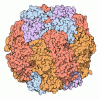登録情報 データベース : PDB / ID : 3kdnタイトル Crystal structure of Type III Rubisco SP4 mutant complexed with 2-CABP Ribulose bisphosphate carboxylase キーワード / / / / / / / 機能・相同性 分子機能 ドメイン・相同性 構成要素
/ / / / / / / / / / / / / / / / / / / / / / / / / / / / / 生物種 Thermococcus kodakaraensis (古細菌)手法 / / / 解像度 : 2.09 Å データ登録者 Nishitani, Y. / Fujihashi, M. / Doi, T. / Yoshida, S. / Atomi, H. / Imanaka, T. / Miki, K. ジャーナル : J.Biol.Chem. / 年 : 2010タイトル : Structure-based catalytic optimization of a type III Rubisco from a hyperthermophile著者 : Nishitani, Y. / Yoshida, S. / Fujihashi, M. / Kitagawa, K. / Doi, T. / Atomi, H. / Imanaka, T. / Miki, K. 履歴 登録 2009年10月23日 登録サイト / 処理サイト 改定 1.0 2010年10月6日 Provider / タイプ 改定 1.1 2011年7月13日 Group 改定 1.2 2021年11月10日 Group / Derived calculationsカテゴリ database_2 / pdbx_struct_conn_angle ... database_2 / pdbx_struct_conn_angle / struct_conn / struct_ref_seq_dif / struct_site Item _database_2.pdbx_DOI / _database_2.pdbx_database_accession ... _database_2.pdbx_DOI / _database_2.pdbx_database_accession / _pdbx_struct_conn_angle.ptnr1_auth_comp_id / _pdbx_struct_conn_angle.ptnr1_auth_seq_id / _pdbx_struct_conn_angle.ptnr1_label_asym_id / _pdbx_struct_conn_angle.ptnr1_label_atom_id / _pdbx_struct_conn_angle.ptnr1_label_comp_id / _pdbx_struct_conn_angle.ptnr1_label_seq_id / _pdbx_struct_conn_angle.ptnr3_auth_comp_id / _pdbx_struct_conn_angle.ptnr3_auth_seq_id / _pdbx_struct_conn_angle.ptnr3_label_asym_id / _pdbx_struct_conn_angle.ptnr3_label_atom_id / _pdbx_struct_conn_angle.ptnr3_label_comp_id / _pdbx_struct_conn_angle.ptnr3_label_seq_id / _pdbx_struct_conn_angle.value / _struct_conn.pdbx_dist_value / _struct_conn.pdbx_leaving_atom_flag / _struct_conn.ptnr1_auth_asym_id / _struct_conn.ptnr1_auth_comp_id / _struct_conn.ptnr1_auth_seq_id / _struct_conn.ptnr1_label_asym_id / _struct_conn.ptnr1_label_atom_id / _struct_conn.ptnr1_label_comp_id / _struct_conn.ptnr1_label_seq_id / _struct_conn.ptnr2_auth_asym_id / _struct_conn.ptnr2_auth_comp_id / _struct_conn.ptnr2_auth_seq_id / _struct_conn.ptnr2_label_asym_id / _struct_conn.ptnr2_label_atom_id / _struct_conn.ptnr2_label_comp_id / _struct_ref_seq_dif.details / _struct_site.pdbx_auth_asym_id / _struct_site.pdbx_auth_comp_id / _struct_site.pdbx_auth_seq_id 改定 1.3 2023年11月1日 Group / Refinement descriptionカテゴリ / chem_comp_bond / pdbx_initial_refinement_model改定 1.4 2023年11月22日 Group / カテゴリ / chem_comp_bond / Item / _chem_comp_bond.atom_id_2
すべて表示 表示を減らす
 データを開く
データを開く 基本情報
基本情報 要素
要素 キーワード
キーワード 機能・相同性情報
機能・相同性情報
 Thermococcus kodakaraensis (古細菌)
Thermococcus kodakaraensis (古細菌) X線回折 /
X線回折 /  シンクロトロン /
シンクロトロン /  分子置換 / 解像度: 2.09 Å
分子置換 / 解像度: 2.09 Å  データ登録者
データ登録者 引用
引用 ジャーナル: J.Biol.Chem. / 年: 2010
ジャーナル: J.Biol.Chem. / 年: 2010 構造の表示
構造の表示 Molmil
Molmil Jmol/JSmol
Jmol/JSmol ダウンロードとリンク
ダウンロードとリンク ダウンロード
ダウンロード 3kdn.cif.gz
3kdn.cif.gz PDBx/mmCIF形式
PDBx/mmCIF形式 pdb3kdn.ent.gz
pdb3kdn.ent.gz PDB形式
PDB形式 3kdn.json.gz
3kdn.json.gz PDBx/mmJSON形式
PDBx/mmJSON形式 その他のダウンロード
その他のダウンロード 3kdn_validation.pdf.gz
3kdn_validation.pdf.gz wwPDB検証レポート
wwPDB検証レポート 3kdn_full_validation.pdf.gz
3kdn_full_validation.pdf.gz 3kdn_validation.xml.gz
3kdn_validation.xml.gz 3kdn_validation.cif.gz
3kdn_validation.cif.gz https://data.pdbj.org/pub/pdb/validation_reports/kd/3kdn
https://data.pdbj.org/pub/pdb/validation_reports/kd/3kdn ftp://data.pdbj.org/pub/pdb/validation_reports/kd/3kdn
ftp://data.pdbj.org/pub/pdb/validation_reports/kd/3kdn リンク
リンク 集合体
集合体
 要素
要素
 Thermococcus kodakaraensis (古細菌)
Thermococcus kodakaraensis (古細菌)
 X線回折 / 使用した結晶の数: 1
X線回折 / 使用した結晶の数: 1  試料調製
試料調製 シンクロトロン / サイト:
シンクロトロン / サイト:  SPring-8
SPring-8  / ビームライン: BL41XU / 波長: 1 Å
/ ビームライン: BL41XU / 波長: 1 Å 解析
解析 分子置換
分子置換 ムービー
ムービー コントローラー
コントローラー








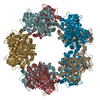
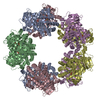
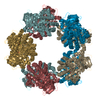
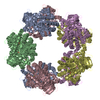
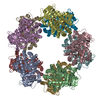
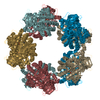
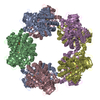
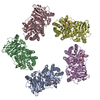
 PDBj
PDBj